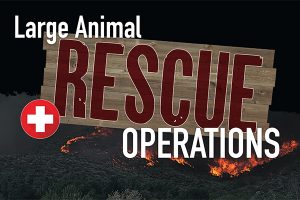Large Animal Rescue Operations
Click here to read the complete article
488 – September/October, 2025
We see it several times every year–whether it is on the evening news on tv, or stories in our hometown newspaper or the internet–horses trapped in high waters after a hurricane has blown in from the Gulf is a heart-wrenching tragedy. We have seen horses stranded far from home in the wake of a tornado that has left a path of destruction across any one of our mid-western states, or as a result of wildfires ravaging California.
Though less devastating than natural disasters, but equally unsettling, are the smaller-scale crises. These are things like horses being stranded on a mountain trail in the high country of Colorado, mired in mud after a slide in North Carolina, or trapped in a trailer after an accident on a Texas Highway.
Far too often the news footage would show how the owner and/or well-meaning passers-by would stop and attempt the rescue, but not knowing what to expect of a horse in distress, they would sometimes make the situation worse. More and more frequently we now see and read about teams of well-trained and highly experienced first responders who know how to keep horses and people safe in these situations and conduct a rescue in a shorter amount of time.
Thankfully, for the past decade or so, equine veterinary practitioners and many members of local fire and rescue organizations have shown an increasing interest in large animal rescue training. In terms of the number of horses whose lives have been saved, their efforts have already proven considerably successful.
Click here to read the complete article
488 – September/October, 2025











